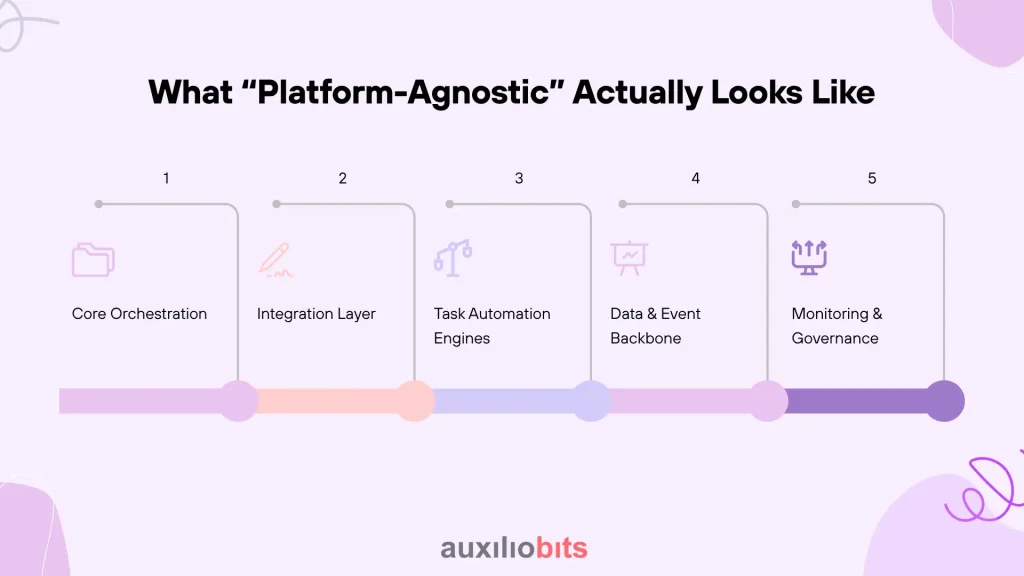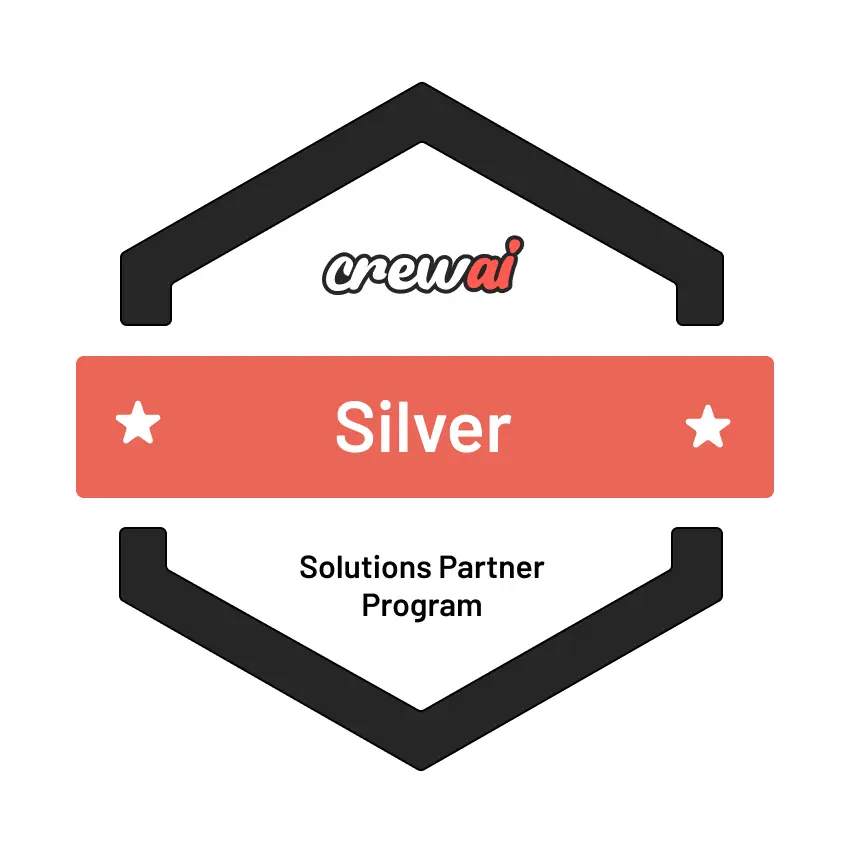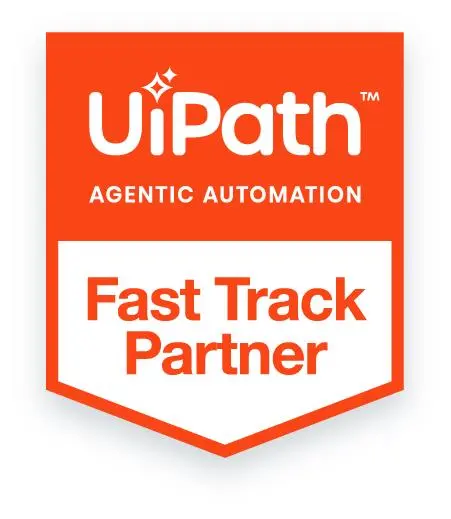
Key Takeaways
- Platform lock-in kills long-term agility. Even the best RPA tool becomes a bottleneck if it can’t integrate cleanly with evolving systems or new cloud ecosystems.
- Agnostic ≠ chaotic. A well-designed, platform-neutral stack has clear layers—Orchestration, Integration, Automation Engines, Data Backbone, and Governance—working in harmony.
- Balance vendor use with escape hatches. Leverage vendor strengths for quick wins, but maintain open architecture to prevent dependency traps.
- Evaluate your context before choosing tools. The right automation stack depends on system landscape, available talent, compliance needs, and scalability goals—not marketing claims.
- Governance and observability are non-negotiable. A platform-agnostic strategy only works when visibility, compliance, and orchestration are centralized, even if execution is distributed.
Automation projects don’t fail because the technology is bad. They fail because the technology is chosen without context. You’ve probably seen it: a shiny new RPA suite gets dropped into a financial services firm, only to be abandoned six months later because half the team is still working in Python scripts, the IT department insists on Azure Functions, and procurement has no appetite for another enterprise license. The result? Fragmented workflows, expensive shelfware, and a CIO who no longer trusts automation pitches.
That’s why the conversation around platform-agnostic automation matters. It isn’t about pushing one vendor or another—it’s about designing an automation stack that integrates across systems, survives organizational politics, and scales without cornering you into a dead-end tool.
Also read: Creating the Digital Nerve Center of Tomorrow with Agentic Workflows
The Problem with Platform Lock-In
Every vendor will tell you they’re “open.” Few actually are. A bank ran into this head-on: they invested heavily in a single RPA vendor, believing the connectors would cover all their needs. Fast forward two years—when they tried to automate workflows across Salesforce, custom COBOL back-ends, and AWS Lambda—they discovered that half of those integrations either required brittle workarounds or extra licensing.
Lock-in doesn’t just mean cost. It often creates silos:
- Developers who prefer Python or Node.js find themselves rewriting everything in a vendor’s proprietary language.
- Business analysts can’t easily test workflows outside of the vendor’s environment.
- Data pipelines stall because integrations into modern event buses (Kafka, Pub/Sub) aren’t first-class citizens.
By contrast, a platform-agnostic approach accepts that no single tool can cover the entire automation lifecycle. Instead, you assemble a stack that spans layers: orchestration, integration, data handling, and monitoring. The emphasis shifts from “What tool should we standardize on?” to “What stack allows us to flex without rebuilding everything each time requirements change?”
What “Platform-Agnostic” Actually Looks Like
It doesn’t mean chaos. It doesn’t mean fifty tools stitched together with duct tape, either. A pragmatic platform-agnostic stack usually has:

- Core Orchestration—Something that coordinates jobs, manages state, and ensures resilience. This might be Camunda, Temporal, or even Kubernetes-based schedulers.
- Integration Layer—APIs, iPaaS platforms like MuleSoft or Workato, or homegrown middleware that handle system-to-system communication.
- Task Automation Engines—RPA platforms for UI-driven tasks, Python/Go services for data crunching, and cloud-native functions for event-driven work.
- Data & Event Backbone—Kafka, RabbitMQ, Azure Service Bus—your plumbing for asynchronous processing.
- Monitoring & Governance – Logging, observability, and access control. You’d be surprised how many “automation programs” skip this until an auditor shows up.
Notice what’s missing? Vendor loyalty. You don’t need to bet everything on UiPath, Power Automate, or Automation Anywhere. Those tools have their place, but they’re not the spine—you build around them.
Case Example: A Manufacturer with Too Many ERPs
A global manufacturing firm had plants running on three different ERP systems—SAP, Oracle, and a homegrown legacy. The CIO’s first instinct was to standardize ERP before pursuing automation. That would have taken five years. Instead, the team built a platform-agnostic automation layer:
- Orchestration: Temporal workflows scheduled tasks across ERP instances.
- Integration: MuleSoft for data harmonization, so that downstream analytics didn’t care whether the order came from SAP or Oracle.
- Automation Engines: UiPath bots for UI scraping on the legacy ERP, serverless Python jobs for clean APIs.
- Data Layer: Kafka topics carried normalized order events into the data warehouse.
The irony? Because the automation stack was independent, they later swapped out Oracle ERP with minimal disruption. Had they locked everything inside one RPA vendor, that ERP migration would’ve been another multi-million-dollar project.
When Agnosticism Goes Too Far
Of course, there’s a risk of overcorrecting. Some organizations chase “agnostic” so aggressively that they end up reinventing the wheel. I’ve seen teams insist on building their own lightweight RPA-like frameworks in Python because they didn’t want to “depend on a vendor.” Sounds noble—until you factor in:
- Maintenance overhead.
- Compliance issues (try explaining your homegrown audit logs to regulators).
- Talent churn (your best developer leaves, and suddenly nobody understands that custom orchestrator).
Platform-agnostic doesn’t mean no platform. It means selective use. Sometimes the smartest choice is to accept a vendor’s ecosystem for 60% of use cases while keeping escape hatches for the rest.
Trade-Offs You Can’t Ignore
When designing a cross-platform automation strategy, trade-offs arise in ways white papers rarely admit.
- Speed vs. Flexibility: A single-vendor RPA solution can deliver quick wins, but long-term flexibility suffers. Agnostic stacks take longer upfront but avoid rewrites later.
- Governance vs. Autonomy: Central IT prefers standardized tools; business units crave independence. Agnostic approaches thrive when governance is policy-based (APIs must log X, bots must authenticate via Y) rather than tool-based (everyone must use Vendor Z).
- Cost vs. Capability: Licensing can balloon fast. But stitching together too many “free” components often leads to hidden costs in support and skills training.
There’s no universal answer—each industry’s regulatory environment, talent pool, and IT maturity will bend the decision.
How to Choose the Right Stack
A framework that’s helped many CIOs I’ve worked with is evaluating the stack across four dimensions:
1. System Landscape
- How many core systems of record exist (ERP, CRM, HR)?
- Are they cloud-based, on-premises, or hybrids?
- Which integration styles are possible—API-first, batch jobs, or only screen scraping?
2. Talent & Skills
- Do you have developers fluent in Python, Go, or .NET?
- Are business analysts comfortable with low-code platforms?
- Is IT willing to maintain Kubernetes clusters, or do they prefer SaaS?
3. Compliance & Security
- Which data flows must be audited?
- Where is data residency a concern?
- How strict are access controls for bots vs. human users?
4. Scalability Horizons
- Is this automation program intended for 10 bots or 10,000?
- Will integrations need to support real-time event-driven processing in the future?
Evaluating these dimensions forces clarity. You start to see why one firm thrives on UiPath + MuleSoft + Kafka, while another gets better mileage from Power Automate + Azure Functions + Service Bus.
Practical Signs Your Stack Is Misaligned
A quick checklist to diagnose misalignment:
- Too many one-off scripts – If your automation catalog is a graveyard of Python and VBA macros with no central orchestration, you’ve under-invested in governance.
- Licensing creep – Costs scaling linearly with each new use case—often signals over-dependence on a vendor.
- Slow change velocity—If adding a new integration takes months, your stack lacks modularity.
- Shadow IT – Business teams bypass official automation tools because they’re too restrictive.
When two or more of these show up, it’s a red flag: time to reassess the stack, not just add another connector.
Small Opinions from the Field
- Low-code tools are overrated for enterprise-grade integration. Great for prototypes, but brittle at scale.
- Event-driven beats are scheduled for resilience. Polling batch jobs feels safe until you need to handle a million transactions in near real time.
- Multi-cloud isn’t a virtue by itself. If you don’t have a strong reason (regulation, customer choice), consolidating on one provider simplifies automation.
- APIs are always better than scraping—until you discover the API omits critical fields. Then you’ll thank your RPA bot.
A Final Story: Retail Gone Wrong
One retailer attempted to automate inventory reconciliation across stores. The IT team mandated a single-vendor RPA platform. The business team complained about missing API integrations, so developers built ugly workarounds. Within a year, the bots were failing twice a week, costing more in downtime than the original manual process.
When leadership finally stepped back, they rebuilt with a platform-agnostic approach:
- Kafka for real-time stock events.
- Serverless AWS functions for reconciliation logic.
- Lightweight bots for the few stubborn legacy interfaces.
- Grafana dashboards for monitoring.
The outcome wasn’t perfect—retail never is—but they could finally scale without firefighting every Friday night.
Conclusion
Platform-agnostic automation isn’t a rejection of tools—it’s a rejection of rigidity. The smartest automation leaders know that today’s stack must serve tomorrow’s unknowns. By focusing on interoperability, governance, and architectural flexibility rather than vendor allegiance, enterprises can keep evolving without constant retooling.
In reality, technology stacks age quickly. Business priorities shift, mergers introduce new systems, and vendors change pricing models. A platform-agnostic foundation cushions you from that volatility. It lets you modernize selectively, swap components gracefully, and maintain trust across teams that work differently but aim for the same outcome—seamless, scalable automation.
True agility isn’t built on a single platform. It’s built on the ability to move across them without starting over.








